Welcome to my tropical Hawaii Fruit Guide! What Fruits To Try When On Vacation On Hawaii!
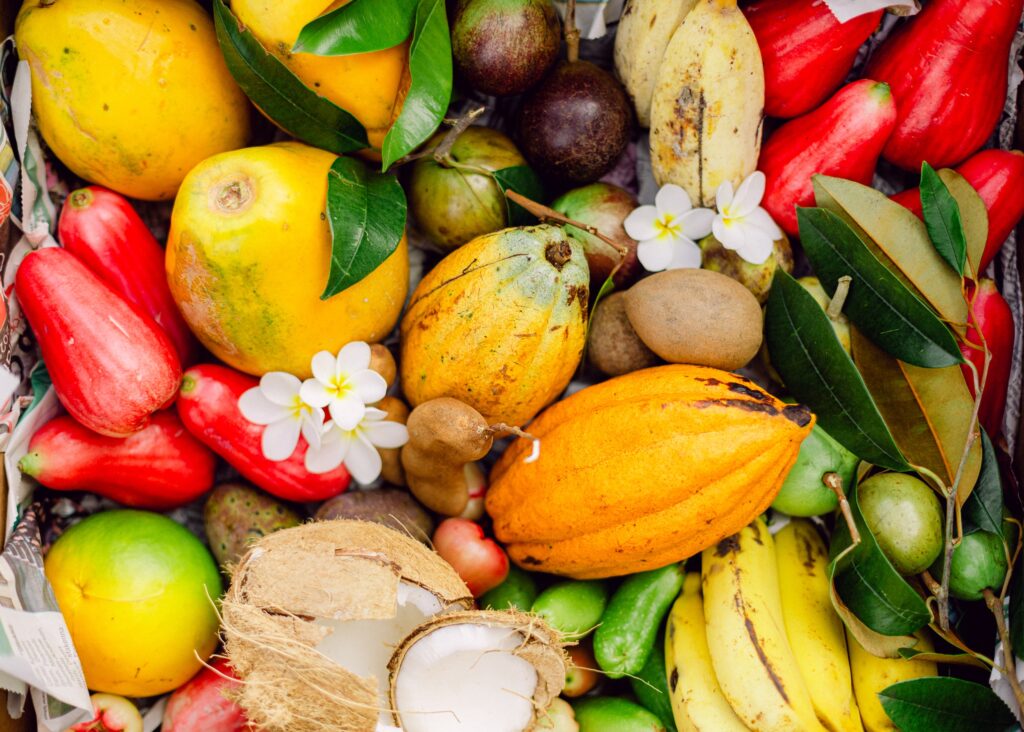
Hawaii is a fruit lover’s paradise, offering an incredible variety of exotic fruits that are as vibrant and diverse as the islands themselves.
In this Hawaii Fruit Guide, we dive into the delightful world of Hawaiian fruits, exploring their tastes, varieties, uses, and how to enjoy them.
Fruits To Try On Vacation To Hawaii
Pineapple
Hawaiian pineapples are famously delicious. If you only ever tasted pineapples from your local mainland grocery store, you are in for a treat!
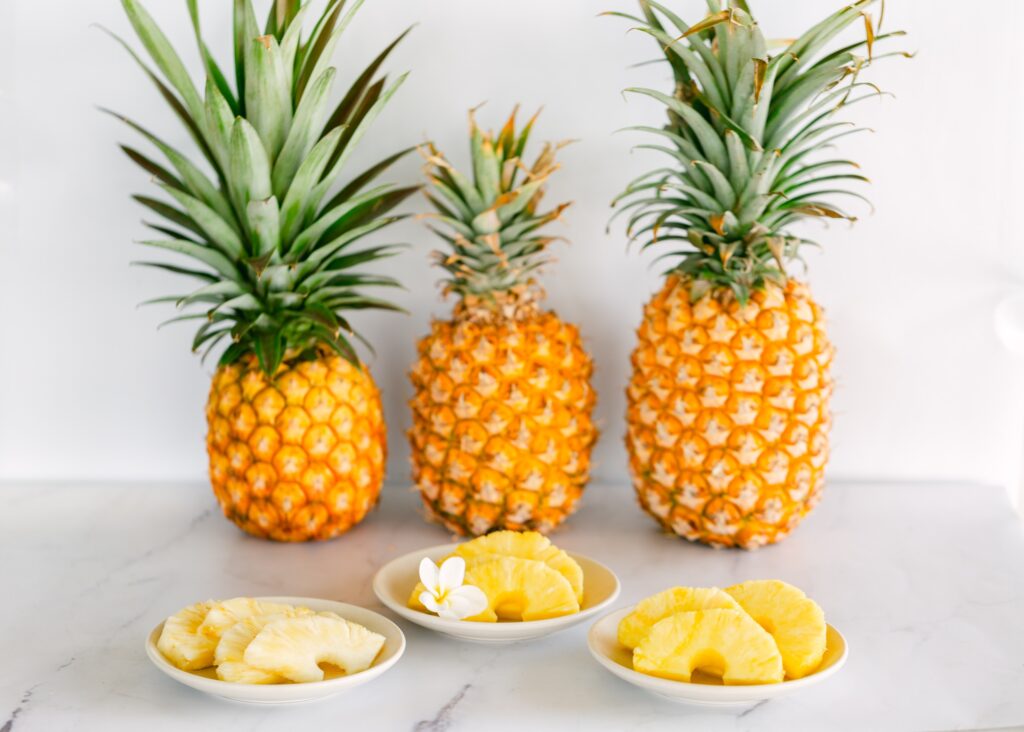
Taste Notes: Juicy and sweet with a vibrant tropical tang.
Varieties: My two favorites are ‘Maui Gold’ and ‘Kauai Sugarloaf.’ ‘Maui Gold is yellow inside and particularly sweet, and Kauai Sugarloaf has very low acidity. Do a taste test to find your Favorite Pineapple Variety on Hawaii.
Culinary Uses: Pineapple is versatile; use it in sweet dishes like upside-down cake or add to savory dishes like teriyaki chicken, burgers, pizza, or seafood curry.
Favorite Pineapple Dish on Hawaii: The Coconut Seafood Curry that comes with a pineapple chutney at Haliimaile General Store. Also their Pineapple Upside-Down Cake.
Season: Year-round, but peak season is from March to July.
How to Eat: Slice off the top and bottom, carve away the outer skin, remove any brown ‘eyes,’ and slice.
It’s Ripe When: You lift it by one of its leaves and the leaf easily comes off.
How It Grows: Did you know that a pineapple is actually a cluster of berries that join together! Like a blueberry. It grows on a bromeliad plant.
Where to Get: At a Hawaii grocery store or a farm, like the Dole Plantation on Oahu, or Maui Gold on Maui. Maui Gold Pineapple Farm is worth a visit all on its own!
Papaya
If you usually don’t like papaya, still give Hawaii’s special strawberry papaya a try. It tastes very different from the papaya you may be used to.
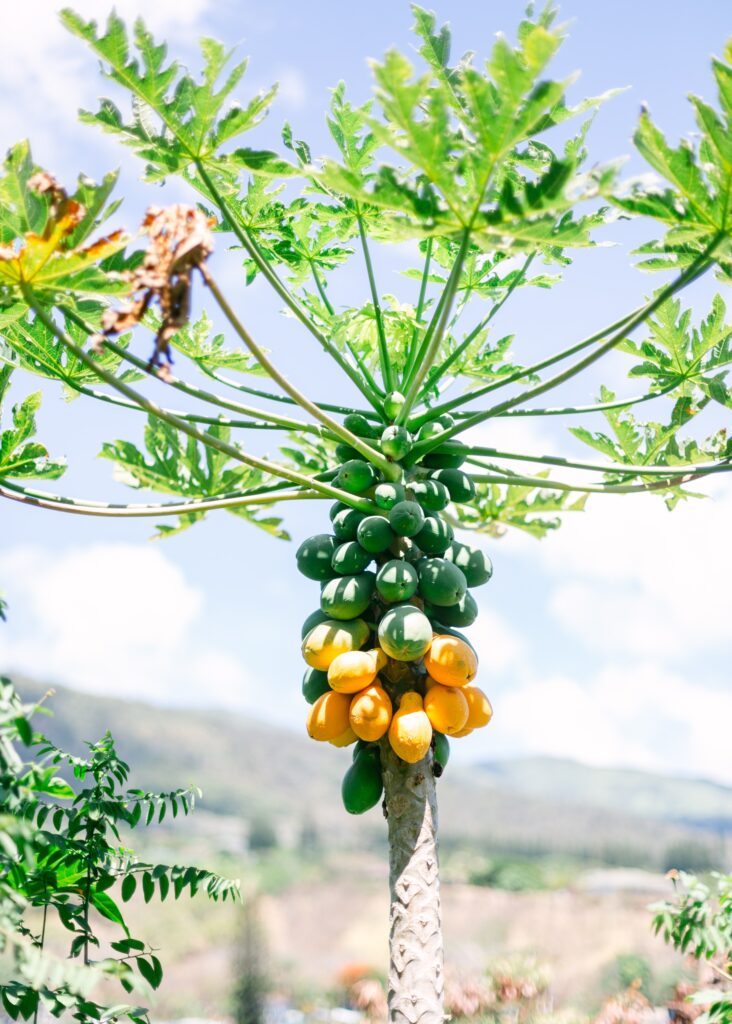
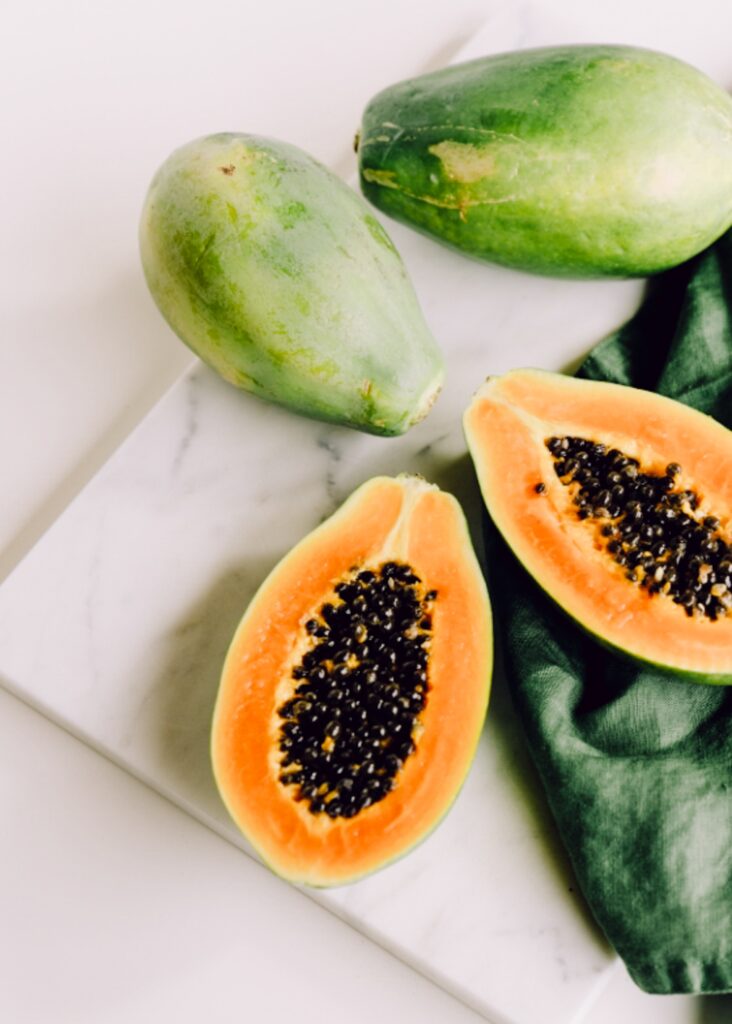
Taste Notes: Sweet with a creamy texture, often compared to melons.
Varieties: There are so many papayas on the islands. From the larger ‘Kapoho’ to the smaller ‘Sunrise.’ Look for a papaya that is pretty small with red flesh. It’s also also called strawberry papaya, and it tastes sweet without any of the usual bitter- or funkiness of regular papaya.
Culinary Uses: Perfect for breakfast bowls, smoothies, or still green in salads. Also used in savory dishes like papaya seed dressing.
Favorite Papaya Dish on Hawaii: Hands-down the Haleakala Beef in a Hana Papaya appetizer at Mama’s Fish House. I order it every time!
How It Grows: Super fast growing tree. Just make sure you grow a female and a male tree together, or that you have a hermaphroditic kind.
It’s Ripe When: The skin turns from green to yellow, the fruit yields slightly under gentle pressure, and it emits a sweet, musky aroma at the stem end.
Season: Available year-round, but best from April to June.
How to Eat: Cut in half, scoop out the seeds (you may keep those for other uses), drizzle some fresh lime juice on it, and enjoy the flesh with a spoon.
Where to Get: Local markets and roadside stands are plentiful with fresh papayas. To get it fresh of the farm visit Ono Farms in Hana or Kumu Farms in Wailuku, both on Maui and both have the yummy strawberry papaya.
Coconuts
Coconut trees were one of the canoe plants that Polynesians brought when they settled the islands, because they have so many uses: from food (fat, water, electrolytes) to building and mulching material, to fabric fibers. Coconut plants are amazing!
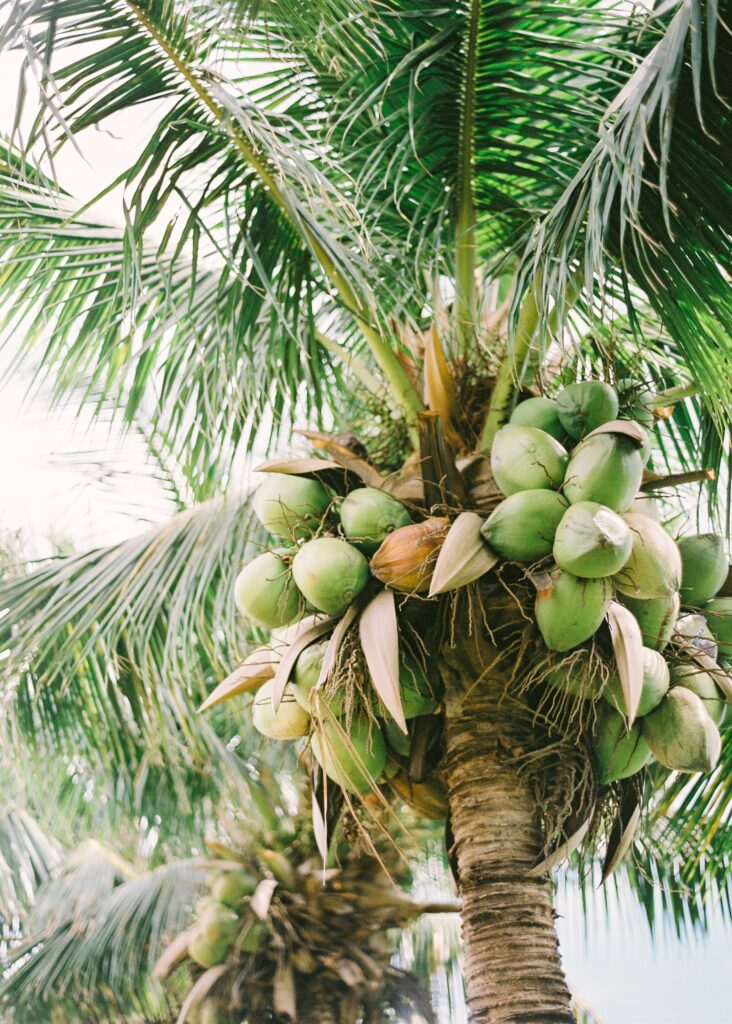
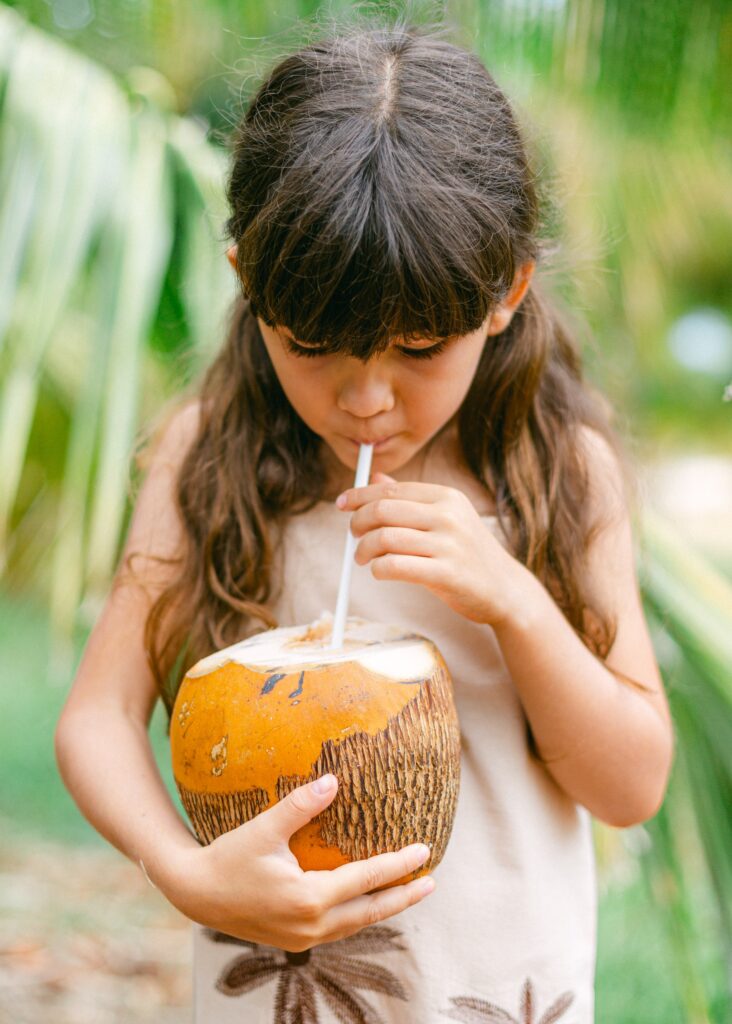
Taste Notes: Fresh coconut water is sweet and hydrating, while the meat is mildly sweet and nutty.
Varieties: Different varieties are grown on the islands. A notable one with delicious water is the Dwarf Samoan.
Culinary Uses: Young green coconuts provide water and jelly-like flesh; slightly older ones yield rubbery meat that can be made into noodles (yes!); and mature brown coconuts provide firm meat used for making milk or shredding.
Favorite Coconut Dish on Hawaii: The Ahi Poisson Cru with Tahitian lime and coconut milk appetizer at Mama’s Fish House. Another appetizer I always order! Also the moringa and cultured coconut pesto from Nui Life Kitchen – super healthy and so yummy!
How It Grows: Unbelievably, coconuts grow according to a 28 day cycle! Every 28 days, you get a new cluster of baby coconuts that then ripen over the coming months.
It’s Ripe When: For poppers (the youngest drinking coconuts) you will hear a distinct reverberating sound when knocking on the green, young coconut. Typically no water can be heard sloshing around. For mature meat coconuts, the husk will be brown and dry and you can hear water sloshing in the vacuum inside.
Season: Available year-round.
How to Eat: Use a coconut key to open young coconuts (sometimes called poppers) and drink the water. As they age, you can crack them open to scoop out the jelly-like flesh. For slightly older coconuts, you can extract the rubbery meat and turn it into a noodle lunch dish. At full maturity, they are brown and used for the meat, which is excellent for making delicious milk.
Where to Get: Almost anywhere on the islands, from beach farm stands to farmers’ markets. Check out Coconut Information on Maui for a whole class and hand-on experience in preparing coconut dishes and drinks.
Lychee
Lychee from the can is nothing like fresh, juicy lychee that’s just come into season! The season is short by Hawaiian standards, so if you have the opportunity, definitely don’t hesitate to try!
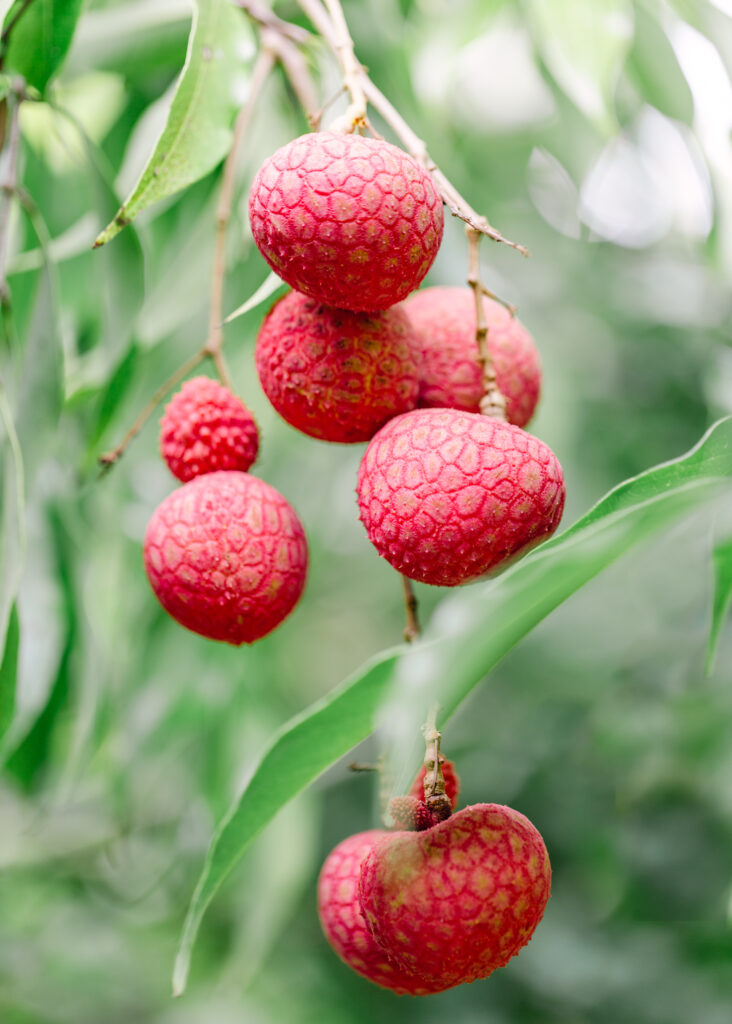
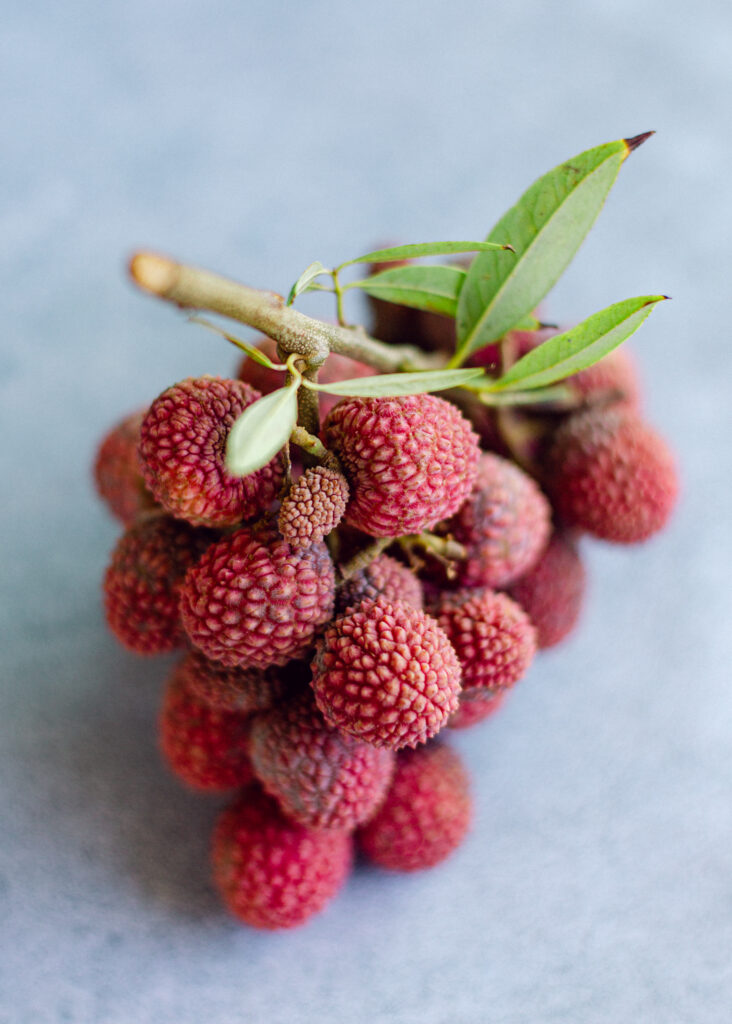
Taste Notes: Sweet and floral, lychee is juicy and refreshing.
Varieties: On the islands, people always talk about how the Big Island has the best fruit. And for lychee, it really seems to be true. ‘Kaimana’ from the Big Island is very popular in Hawaii.
Culinary Uses: Eaten fresh or used in desserts, cocktails, and salads. Try this amazing coconut ceviche recipe!
Favorite Lychee Dish on Hawaii: A bag taken to the beach as a snack between swims!
Growth: A large tree that thrives in Hawaii’s warm, humid climate with a dry winter.
Season: Short season in early summer.
How to Eat: Peel the rough skin and eat the juicy flesh around the pit.
It’s Ripe When: Lychees are generally sold ripe.
Where to Get: Farmers’ markets and specialty stores when in season. Check out O.K. Farms on the Big Island. Their farm tour is wonderful too!
Jackfruit
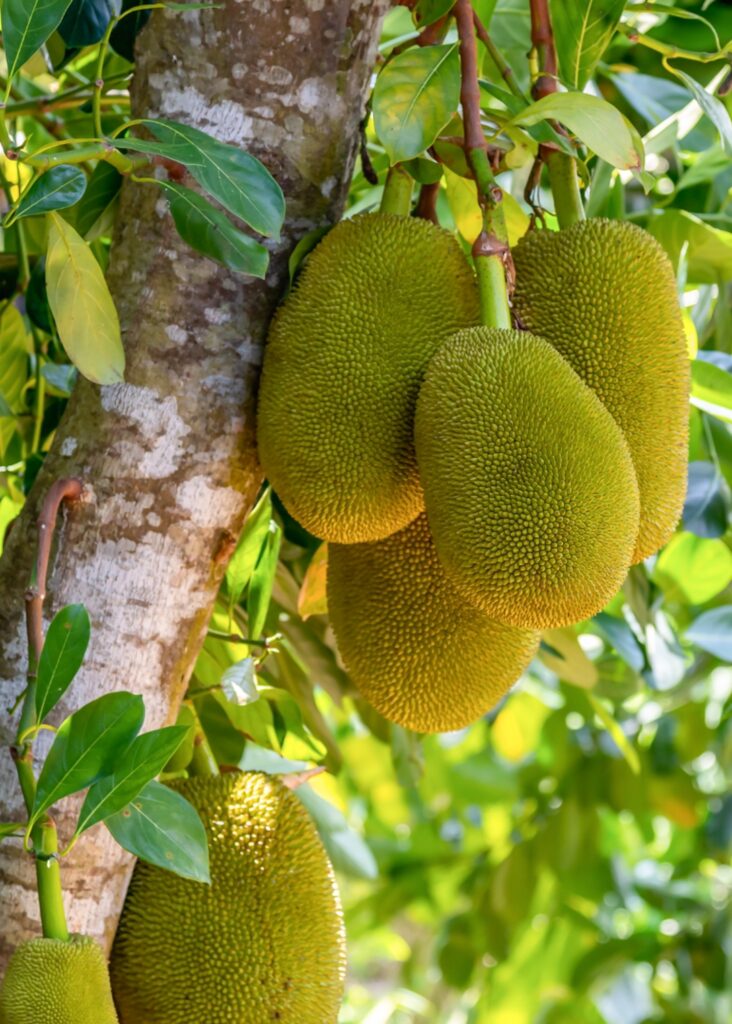

Taste Notes: Sweet and fragrant, similar to a combination of apple, pineapple, mango, and banana. It’s said that Juicy Fruit gum was inspired by the flavor of jackfruit.
Varieties: Many different kinds, some with firmer or softer meat textures.
Culinary Uses: Ripe fruit is sweet and used in desserts, while unripe fruit can be cooked in savory dishes, like vegan pulled pork.
Best Jackfruit Dish on Hawaii: The BBQ Jackfruit Sandwich at Moku Roots.
How It Grows: On a tree with prickly fruit that grows quite large, with some fruits weighing over 40 pounds!
Season: Summer is the prime season for jackfruit.
How to Eat: Tear open and remove the fibrous pods. Don’t eat the seeds.
It’s Ripe When: The skin turns from green to yellow-brown, it emits a strong, sweet fragrance, and the fruit gives slightly under pressure.
Where to Get: Look for it at local farmers markets.
Guava
Guava grows so ubiquitously on the islands, it even has its own catchy song.
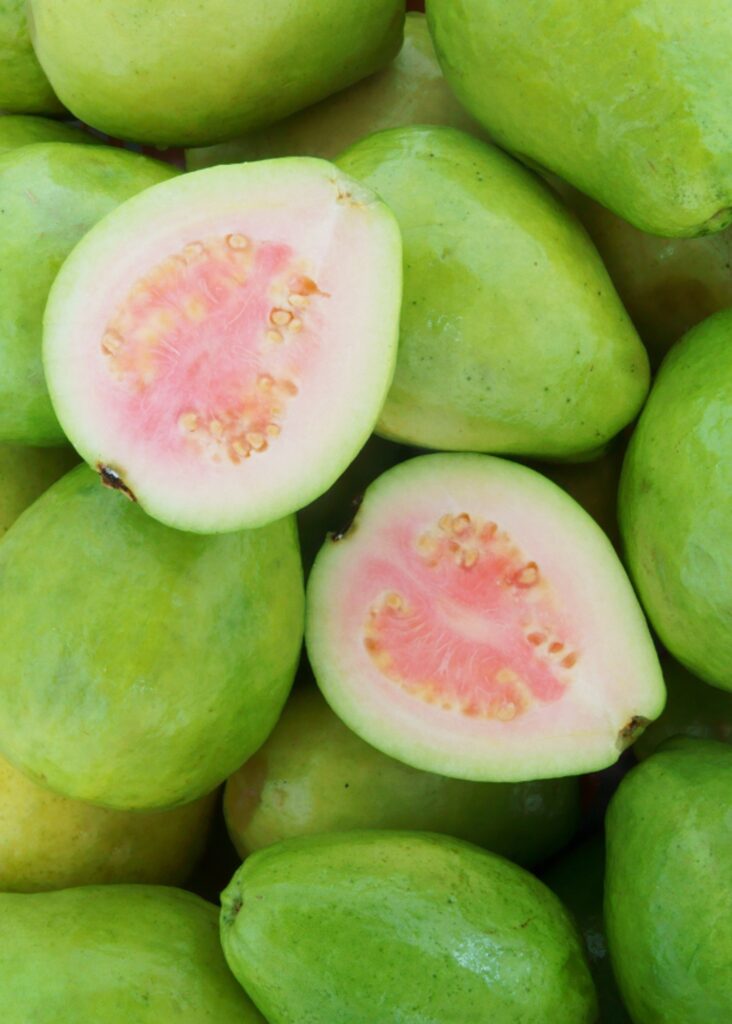
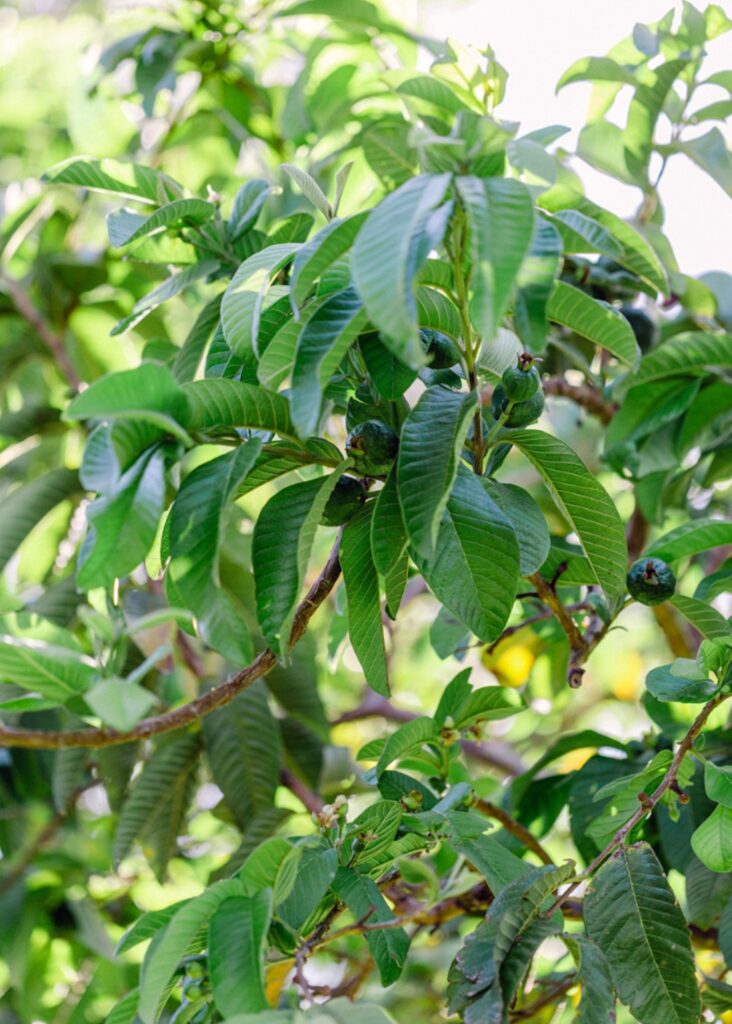
Taste Notes: Sweet and slightly tangy, with a strong, fragrant aroma. Something like a warm honey or apricot fragrance.
Varieties: Several types including pink and white fleshed.
Culinary Uses: Delicious in jams or jellies. I particularly love guava jam on a prosciutto grilled cheese! It’s also great in pastries and drinks.
Favorite Guava Dish on Hawaii: I forgot where, but I’ve had a guava steak that was delicious. If you see, give that a try!
Growth: Grows as a bush or small tree in tropical climates. You’ll find the fallen fruits in rainforest thickets.
Season: Almost all year, with a peak from summer to fall.
How to Eat: Rinse and eat whole or cut into slices. Avoid the seeds.
It’s Ripe When: When the guava turns light green or yellow, emits a strong, sweet aroma, and feels slightly soft when gently pressed.
Where to Get: Widely available in local supermarkets and specialty food stores.
Visiting Hawaii Fruit Farms
All of the fruits mentioned in our Hawaii Fruit Guide are grown on local farms across the islands, which often offer tours and direct purchases.
Here is a blog post on the Best Farm Tours on Maui.

These tours provide a fantastic opportunity to learn about tropical agriculture, taste fruits straight off the tree, and support local agriculture.
Whether it’s a pineapple field on Maui, coffee farm on Kauai, or a lychee orchard on the Big Island, visiting these farms can be a highlight of your trip.
So what’s your favorite fruit?
Why Trying Hawaii’s Exotic Fruit Is A Must Do
From the lush fields of pineapples to the dense groves of lychee, Hawaii’s fruits are as much a part of the island experience as the beaches and volcanoes.
Whether you’re sipping on a fresh coconut on the beach, enjoying a papaya smoothie for breakfast, or trying some homemade guava jam, the fruits of Hawaii offer a delicious slice of island life.
Plus it’s an inexpensive, healthy, and fun way to explore more of Hawaii’s nature. And kids love it, too!
What Fruit Is In Season On Hawaii
Seasonality in Hawaii can be a bit unintuitive for visitors from the mainland. When produce is in season in Hawaii, it raises many questions, and the answers can be surprising. For example:
- Are strawberries in season in Hawaii? If so, when are strawberries in season? They’re in season from February to April!
- Is there a pineapple season in Hawaii? Pineapples are grown and harvested year-round in Hawaii, with a peak season from March to July.
- What is the season for papaya in Hawaii? Papayas are grown and harvested year-round in Hawaii, with a peak.
- When is mango season in Hawaii? Mango season in Hawaii is from May to September, with different varieties peaking one after the other.
- When is lychee ripe in Hawaii? Lychee season peaks between May and August in Hawaii.
For a quick glance at seasonality in Hawaii, check out our Infographic: What Fruit Is In Season in Hawaii?
Hawaii Fruit Guide – Part 2
For part two of the Hawaii Fruit Guide, check out this blog post where we discuss more not-to-miss exotic fruits such as mango, sapote, cacao, various types of bananas, egg fruit, starfruit, soursop, durian, loquat, and lilikoi await you in Hawaii.
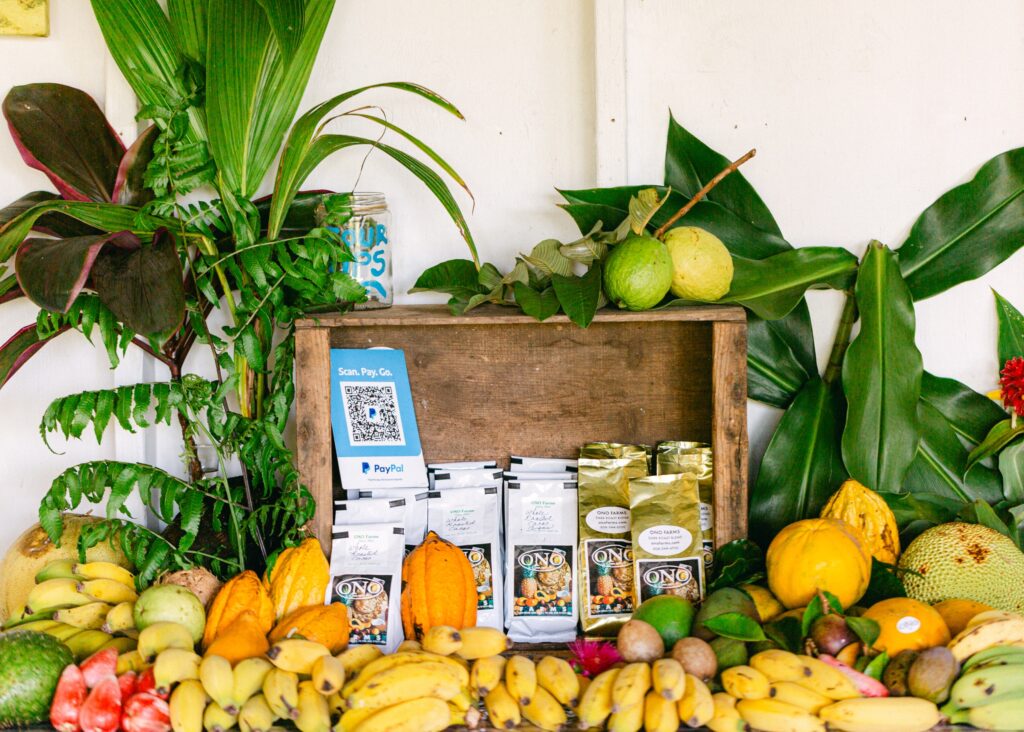
Each of these fruits offers a unique taste that enhances your tropical adventure.
Happy tasting! And let us know what your favorite Hawaii fruit is.
CONTINUE YOUR JOURNEY THROUGH HAWAII’S NATURE
Check out these popular Hawaii farm & wellness blog posts:
> Tips For Maui Farmer’s Markets
> Cutest Hidden Maui Farm Stands
If you love Hawaii and you enjoy wellness vacation tips, beauty secrets, and DIY recipes, then sign up for my newsletter where I explore different beauty rituals from Hawaii and around the world.

Hawaii Fruit Guide
Highlights:
Book Now
Experience the transformative power of Hawaii's natural botanical ingredients and harness the healing energy of the islands at our DIY cosmetics workshops, where you create your own personalized beauty products.
Reserve your spot today and embark on a fun, rejuvenating journey of self-care and holistic wellness.